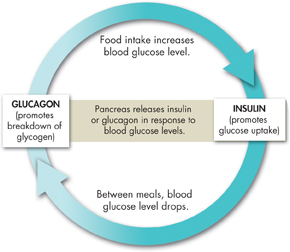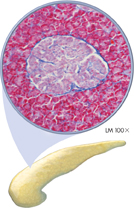Pancreas The pancreas is both an exocrine and an endocrine gland. As an exocrine gland, it releases digestive enzymes that help break down food. However, other cells in the pancreas release hormones into the blood.

FIGURE 34–7 Blood Glucose Control Insulin and glucagon are opposing hormones that ensure blood glucose levels stay within a normal range. Infer Explain why this feedback loop does not apply to a person with untreated diabetes.
dThe hormone-producing portion of the pancreas consists of clusters of cells. These clusters, which resemble islands, are called the “islets of Langerhans,” after their discoverer, German anatomist Paul Langerhans. Each islet contains beta cells, which secrete the hormone insulin, and alpha cells, which secrete the hormone glucagon.  Insulin and glucagon, produced by the pancreas, help to keep the blood glucose level stable.
Insulin and glucagon, produced by the pancreas, help to keep the blood glucose level stable.
▸ Blood Glucose Regulation When blood glucose levels rise after a person eats, the pancreas releases insulin. Insulin stimulates cells to take glucose out of the blood, which prevents the levels of blood glucose from rising too rapidly and ensures that glucose is stored for future use. Insulin's major target cells are in the liver, skeletal muscles, and fat tissue. The liver and skeletal muscles store glucose as glycogen. In fat tissue, glucose is converted to lipids.
Within one or two hours after a person has eaten, when the level of blood glucose drops, glucagon is released from the pancreas. Glucagon stimulates the liver and skeletal muscle cells to break down glycogen and release glucose into the blood. Glucagon also causes fat cells to break down fats so that they can be converted to glucose. These actions help raise the blood glucose level back to normal. Figure 34–7 summarizes the insulin and glucagon feedback loop.
▸ Diabetes Mellitus When the body fails to produce or properly respond to insulin, a condition known as diabetes mellitus occurs. The very high blood glucose levels that result from diabetes can damage almost every system and cell in the body.
There are two types of diabetes mellitus. Type I diabetes is an autoimmune disorder that usually develops in people before the age of 15. The immune system kills beta cells, resulting in little or no secretion of insulin. People with Type I diabetes must follow a strict diet and receive daily doses of insulin to keep their blood glucose level under control.
The second type of diabetes, Type II, most commonly develops in people after the age of 40. People with Type II diabetes produce low to normal amounts of insulin. However, their cells do not properly respond to the hormone because the interaction of insulin receptors and insulin is inefficient. In its early stages, Type II diabetes can often be controlled through diet and exercise. Unfortunately, the incidence of Type II diabetes is rising rapidly in the United States and other countries as a result of increasing obesity, especially among young people.

FIGURE 34–8 Pancreas Cells The cluster of light-colored cells is an islet of Langerhans, which contains alpha and beta cells. In Type I diabetes, a person's immune system kills beta cells, which produce insulin.

Table of Contents
- Formulas and Equations
- Applying Formulas and Equations
- Mean, Median, and Mode
- Estimation
- Using Measurements in Calculations
- Effects of Measurement Errors
- Accuracy
- Precision
- Comparing Accuracy and Precision
- Significant Figures
- Calculating With Significant Figures
- Scientific Notation
- Calculating With Scientific Notation
- Dimensional Analysis
- Applying Dimensional Analysis




